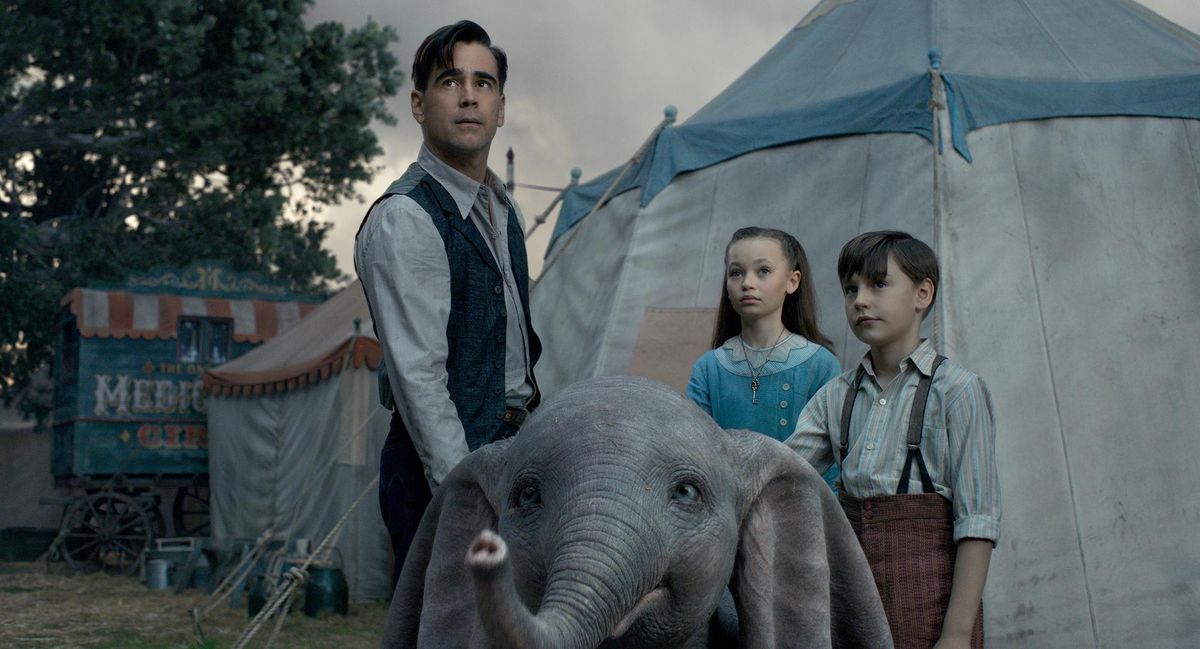Review: Tim Burton’s ‘Dumbo’ remake is decidedly – and deliciously – dark

Tim Burton’s remake of “Dumbo” – a live-action and CGI version of Disney’s 1941 classic about a flying baby elephant – is more an expansion of the original than simply a souped-up retread. For one thing, it’s nearly twice as long as the earlier, sweet-but-slight film, which was itself inspired by a mere handful of unpublished sketches made for a scrolling picture-book series called “roll-a-books.”
For another, the new story is decidedly, deliciously dark, veined with thin layers of Burton’s trademark macabre sensibility, which adds texture and tartness to the inherent charm of the story (at heart, one about the parent-child bond and the possibility of the impossible). Working from a new screenplay by Ehren Kruger, who wrote the first two American “Ring” films and other creepy tales, Burton has made a movie that does Disney proud, honoring the simple appeal of the source material while finding new emotional resonance in the narrative.
“Dumbo” doesn’t waste any time drawing our attention to the shadows, opening in 1919 in Sarasota, Florida, where the ragtag circus at the center of the film spends its winters. Holt Farrier (Colin Farrell) is a returning veteran who has not only just lost an arm (in the Great War) and his wife (to influenza), but his old job as well. No longer able to work as the circus’s trick Western rider, Holt is reassigned by the owner/ringmaster (Danny DeVito) to take care of the elephants, a demotion that involves shoveling, well, you know what. But soon, real trouble arrives: the female Indian elephant Jumbo, who has just given birth to a calf with comically oversize ears, accidentally kills – yes, kills – a sadistic animal trainer (Phil Zimmerman), and Mom is sold off as a “mad” animal, leaving Dumbo, as her son has been nicknamed, disconsolate.
Kudos to the team of digital animators. Dumbo is as expressively adorable as any human actor in the film, which includes many nearly wordless turns by supporting characters as circus performers (especially Sharon Rooney as the maternal “mermaid,” Miss Atlantis, who covers the classic tune “Baby Mine”). The digital pachyderm is a fully formed character, even though, as in the original film, he never speaks a single word of dialogue. None of the animals do, even the tiny, uniformed circus mouse who replaces the first film’s chatty sidekick Timothy Q. Mouse.
Timothy’s duties as the title character’s mentor fall to Holt’s children (Nico Parker and Finley Hobbins), whose discovery that Dumbo can fly eventually lands him a role as the star attraction in a new, much larger circus called Dreamland. But Dreamland, true to Burton’s form, is run by a shady character (Michael Keaton), whose amusement-park-like complex includes a scary house-of-animal-horrors called, appropriately enough, Nightmare Island.
Parents, heed me: “Dumbo” is a beautiful movie, but it’s PG for a reason. Tender hearts may flutter at some of the film’s scarier moments, which include the threat of flames and a sinister character who wears elephant-skin boots. The implications are morbid, especially for a Disney film.
Because this is Disney, there are a few moments that strain to deliver a message of self-conscious positivity and possibility, no matter how anachronistic. Holt’s daughter, for instance, is an aspiring scientist who earns eye-rolls from her father for her unladylike ambitions, which she articulates at the drop of a hat. Nothing wrong with girl power, of course, but Dreamland also includes a “world of tomorrow” display that features – in 1919 – a working mother and a stay-at-home dad.
It’s cute and, in context, meant to be funny. And it is.
“Dumbo” is by no means a downer. As cartoonish as they are, the film’s Burtonesque touches lend the magic and the fantasy of the story a quality of paradoxical verisimilitude. You’ll need to believe that an elephant can fly. And for an hour or two, you will.
To paraphrase Keaton’s V.A. Vandevere, upon witnessing an elephant take flight, “Dumbo” will make you a child again.